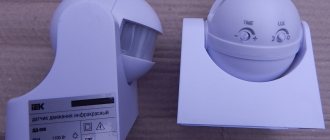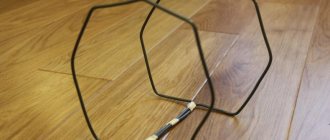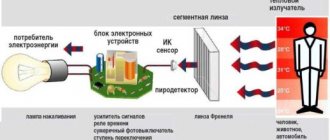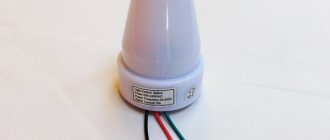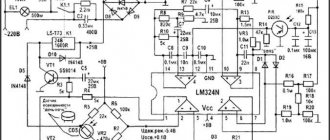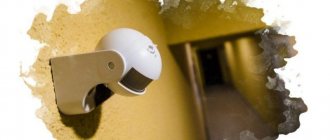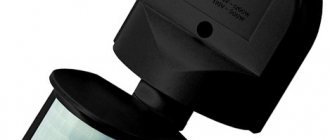In the 90s of the last century, devices for automatically turning on/off lights quickly burst into human everyday life. In Western European countries, the installation of these lighting devices for staircases, landings and adjacent areas has begun to bring significant energy savings for homeowners. Already in the early 2000s, they began to be widely used in Russia. The motion sensor DD 024 is one of the most popular models among all sensor devices.
DD 024
The device is designed to save electricity spent on lighting rooms and adjacent areas. DD 24 reacts to the appearance of a person by turning on the lighting devices for a specified period of time after the cessation of movement in the control field.
What it looks like and where it is used
The horizontal sensor looks like a volumetric toroidal disk that is attached to the ceiling. Other devices come in wall-mounted and corner versions. The horizontal model provides comprehensive coverage of the controlled area with a full viewing angle of 3600. The remaining DDs have a viewing angle of 1200 and 1800. Usually the device is painted white or black.
The DD body is made of polycarbonate, in the center of which a screen with a Fresnel lens in the form of a cap is inserted. Next to it are the adjustment screws. Depending on the model, the device may have 2 or 3 setting functions. These are the illumination, delay and sensitivity screws.
Ceiling DDs are installed at the top on the floors of passage rooms - these are corridors, lobbies, landings and flights. Also, sensor machines are installed inside warehouses and other technical rooms. If the room has two doorways in adjacent walls, then install corner models. In other cases, the device is hung on one of the fences, but not opposite the windows. Direct sunlight can have a detrimental effect on the condition of photocells.
Ceiling motion detector 024
Important! Motion sensors are often used in security systems, where they not only turn on the lights, but also activate video equipment, sound alarms, etc. Street sensors are mounted on the facades of houses, free-standing vertical structures for the protection and illumination of persons who have illegally entered private territory.
Infrared motion sensor DD-024-W 1200W 180-360 degrees. 12m, IP33 white
HOW TO RECEIVE AN ORDER?
Pickup
1) SHOWROOM on Timiryazevskaya street.
You can pick up your order placed on the website at the address: Moscow, st. Timiryazevskaya, building 2/3, (metro station Dmitrovskaya), T/C “PARK 11”, 2nd floor, pavilion No. C39.
— reserve an UNPAID order until the end of the store’s current business day from the moment the availability of the required quantity is confirmed, then the reserve can be removed at the discretion of the store;
— A PAID order is stored for 7 calendar days, then sent to the warehouse.
LOCATION
Enter the PARK 11 shopping center. Go to the escalator and go up to the 2nd floor. Once you have taken the escalator to the 2nd floor, go straight without turning anywhere to the “LAMINATE” department, then turn left and walk straight 50 m. Next to our store there is a store “LOCKS” and “STUCTURE”.
ATTENTION!
Shipment at online store prices only based on an order. Prices in the retail department and online store are different. Full information about the store location...
2) Delivery to pickup points - Order pick-up points.
Boxberry pickup point - calculated automatically
SDEK - calculated automatically
5Post - in Pyaterochka stores and parcel terminals - calculated automatically
——————————————————————————-
— Delivery of your order in Moscow and St. Petersburg inside and outside the ring up to 15 km.
Delivery costs are valid only for individuals. individuals, for companies everything is calculated individually. Tariff: dimensions 60x100x10 cm up to 3 kg - from 299 rubles, dimensions 60x100x10 cm from 3 kg to 6 kg - from 350 rubles, dimensions 60x100x10 cm from 6 kg to 10 kg - from 600 rubles, etc. more than the specified dimensions and more than 19 kg - individually. Full description of delivery conditions...
——————————————————————————
— Delivery throughout Russia t/k.
Delivery costs are calculated depending on the location of branches and weight.
Payment for services by t/c upon receipt of the order. Delivery conditions in Russia...
—————————————————————————
HOW TO PAY FOR YOUR ORDER
Please note that the price in the online store is indicated in rubles. The final price includes all taxes. You can pay for an order in the online store in the following ways:
— Cash or card to courier.
Payment is made to the courier upon receipt of the order (only in Moscow).
— Electronic payment method via the website:
Payment from an account in Yandex.Money Payment from a bank card Payment by code through a terminal Payment from a mobile phone account Payment from a WebMoney account Payment through Sberbank Online Payment in Alfa-Click Payment through a mobile terminal (mPOS) Payment through MasterPass Payment through Promsvyazbank Internet banking Payment through QIWI Wallet Payment through KupiVcredit (Tinkoff Bank) Payment through Trusted Payment (Kuppi.ru) Internet payments are protected by an SSL certificate and the 3D Secure protocol. Before paying, please wait for confirmation of the required quantity of goods for your order - this will take the shortest possible time.
— By bank transfer for legal entities. persons (we work with VAT).
ATTENTION! Accounts are accepted for work only from 3000 rubles. If this happens, and you did not notice that the order is less than 3,000 rubles. and have already paid, we will be forced to return the money back.
How to create a request and pay: select a product, enter your company details, select a delivery method, select a payment method “by bank account number for legal entities. persons with VAT”, confirm the application. An invoice will be automatically sent to you. When transferring the paid goods, you are provided with original documents (original invoice, auction 12, invoice). The order is executed within 3 working days after the funds you transferred appear in our bank account. If you inform us about the payment made (it is important for us to know the date and number of the payment order), this will significantly increase the speed of order execution. Please note that the account is valid for 3 business days, not counting the day of formation.
Note! Along with the goods, payment documents and warranty cards are required.
How the device works
Infrared motion sensor
The functioning of the infrared motion sensor DD 024 is carried out due to the combined interaction of its three component parts, these are:
- Optics;
- Heat sensor;
- Control block.
Optics
The optical system is a polymer hemisphere located in the center of the device. The plastic cap is covered on the inside with many tiny lenses, which are combined into a single system called a Fresnel lens. Its task is to focus the infrared radiation of the viewing area on the photocells of the pyroelectric detector.
Heat sensor
The heat sensor, or pyro-receiver, is an electronic head in the form of a hemisphere located under a Fresnel lens. The surface of the head is covered with sensitive micro photocells. As soon as the intensity of the focused IR rays changes, the voltage level in the pyroelectric receiver immediately changes. The control unit receives information about this.
Control block
The operating unit is an electronic circuit that evaluates the degree of change in the intensity of the IR background. If this indicator reaches a certain level, then a relay is activated, which turns on the connected light sources. Connected lighting devices can be of different types.
How the motion detector works
Design and operating principle of DD 024
The main element of the device is the infrared motion sensor itself, operating under the control of a controller, which receives and analyzes information about movement and light level and issues a command to open the contacts in the electromechanical relay.
The operating principle of this device is based on the sensitivity of the sensor. When a moving object appears in the IR field of the device, the microchip receives information about this, and the controller analyzes the information about the level of illumination. After this, it issues a command to open the contacts and turn on the connected light sources, this is in the event that the lighting level is below the specified parameter, or remains in standby mode if the lighting corresponds to the programmed parameters.
This is necessary to ensure that the automation does not operate during daylight hours. Quite a convenient function of the device.
Operational and technical parameters of DD 024
Wireless motion sensor
DD 024 instructions contain the following technical specifications:
- Working power supply – 220 V/50 Hz.
- Delay time (Time) – adjustable from 10 seconds to 20 minutes.
- Light sensitivity (Lux) is adjusted to the desired level of room illumination at which the sensor should be triggered.
- The maximum operating range of the DD is 6 meters.
- The moment of operation of the device depends on the speed of movement of the person in the control zone - this is 0.5-1.5 m/sec.
- Switched current – 1.1 kW.
- Viewing angle for models:
- ceiling - 3600;
- wall - 1800;
- corners – 1200.
Motion sensor DD 024
Tracking device in a round plastic case with a diameter of 118 mm. A viewing angle of 360 degrees makes it possible to install this device on the ceiling, which provides optimal coverage of the surrounding area. The radius of the sensor is six meters. This allows you to use the sensor as a wall sensor, but then the device’s vision will narrow to 120 degrees (in this case, 360 is useless, so don’t be afraid of it).
The temperature range at which this device can operate is quite wide (-20/+45 degrees Celsius), and protection from rain splashes and small debris allows it to be used outdoors - it is not afraid of rain.
The type of sensitive element of this device is infrared.
What is an IR sensor?
This type of analyzer is capable of recognizing the thermal characteristics of its environment. Some are a little colder, some are warmer.
The infrared detector is equipped with special optical devices - Fresnel lenses - with the help of which movement within the device’s coverage area is recognized. The more lenses in the sensor, the more accurate and sensitive it is. Outwardly, such a sensitive element resembles frosted glass with a cellular structure (honeycombs, squares, etc.), the more such cells there are on the glass, the better it is, accordingly.
The passive operating principle of an infrared device makes it the safest of all types of sensors, since it is equipped only with a receiver and does not emit anything into the environment.
IR sensor
One of the features of such a device is that it copes with its work much more easily in cool ambient conditions. Despite the fact that the operating temperatures of the sensors can reach forty and fifty degrees above zero, it detects movement better and more successfully at +20 than at +30. After all, the cooler the general background, the easier it is to see the warmth of a living creature and its movement.
Pros of the IR sensor:
- safety;
- simplicity;
- low cost.
Minuses:
- inability to work through obstacles (even fabric);
- demands for cleanliness;
- failures in the presence of heat sources in the immediate vicinity.
But, if you follow all the rules when choosing an installation location, it will work properly and perform the functions it should.
It is also worth considering that movement that is perpendicular to the working area of the device is much better recognized, and not parallel to it. Based on this, it makes sense to mount the device not opposite the front door, but on the wall adjacent to it. This does not apply to ceiling-mounted types of devices, since in this case, activity from any side will go across the detector area.
Let's return to the description of the DD motion sensor from IEK.
The device voltage is 230 V, and the maximum permissible total load on the device is 1100 W, which makes it possible to connect the motion sensor to several lamps at once.
When choosing the power of the detector, it is also necessary to take into account what kind of lamps the owner of the room uses, since the difference between ten 100 W halogen lamps and the same number of LED illuminators, for example, 14 W each, is obvious.
Installation of DD 024
To install sensor devices on walls made of concrete or brick, both inside and outside, a hammer drill is used. Installation is carried out in the following sequence:
- On the back panel of the device, measure the distance between the centers of the mounting holes, if there are two of them. You can do it easier - remove the back panel and, placing it on the fence, outline the holes with a pencil;
- On the surface of the fence, the attachment location is selected based on the planned control sector. For horizontal detectors this will be the center of the ceiling. For corner and wall devices, the attachment points are marked so that the DD covers doors or arched passages;
- Use a hammer drill to drill holes for the dowels. They are driven into the finished holes with a hammer. Then screws are screwed into them so that the heads protrude to a convenient height for the sensor mounting holes;
- Start wiring. This is done openly or covertly. Electrical wiring is attached to the walls and ceiling with dowels and clamps, laid in grooves followed by plaster or hidden in boxes;
- Having connected the detector to the power supply, hang it with its back side on the screws.
Note! The connection to the sensor outlets is made using screw or knife terminal blocks. Under no circumstances should you make twists - this can lead to damage to the sensor or other negative consequences.
Connection diagram DD 024
On the back panel, the manufacturer usually pastes a sticker with a diagram of how the detector is connected to the power wires and lighting devices. There, three outlets of wires of different colors are routed through the hole. The red wire (L) is a phase, blue (A) is from light sources, black or brown (N) is zero. A schematic diagram of the DD connection is included in each manual included with the product.
The three supply conductors must have a cross-section of at least 1.5 mm2. To avoid mixing up the wires, you need to use a screwdriver tester. It is better to mark the wire from the lighting lamps in advance with a marker. Connections are made in such a way that the terminal blocks are hidden behind the sensor housing.
Rear panel of the device with connection diagram
Checking the connected motion sensor
If the detector is installed in an enclosed area without windows, the detector should turn on the light immediately after connecting power to it. If the DD 024 is installed in a room with window openings, the conditions for triggering the device are created by adjusting the adjusting screws located on the front panel of the DD.
Check the correct settings of the touch device experimentally. The adjuster begins to approach the control zone several times under conditions of varying degrees of natural light in the room. Typically, final tuning is completed after three test runs.
Additional Information. If the homeowner does not have experience working with electrical equipment, then you should not attempt to connect a motion sensor yourself. You need to contact a professional. He will quickly install the device, connect it to power and configure it as the owner needs.
View of the DD with the cover removed
Setting up and adjusting DD 024
There are three adjusting screws with the following letter designations on the front panel:
- LUX – degree of illumination of the control zone;
- TIME – light switch-off delay time;
- SENS – sensitivity of the device to the volume of the object.
The DD adjustment is made with these three screws. The settings are carried out sequentially in the following order:
- The LUX screw is turned to the extreme right position. This is the maximum degree of illumination of the control zone. Gradually, by moving the regulator back, the device is activated at dusk or in complete darkness.
- The TIME screw is used to set the period of time when the light does not turn off when there is complete absence of movement in the “field of view” of the detector. This function is needed when a person passes through a room and returns after a while.
- The SENS function is useful for outdoor models and indoor sensors. The main purpose of this option is to distinguish people and not react to small animals (dogs, cats, etc.). Sensitivity adjustment is carried out experimentally. As a last resort, the screw is set to the middle position.
Setting up a motion sensor
DIY motion sensor
Next, you need to calibrate the sensor. To do this, there are three adjusting screws located under the protective cover:
- “LUX” – illumination level;
- “TIME” – time period;
- “SENS” – IR field sensitivity.
The regulators are installed manually by turning the adjustment screws in one direction or another; the product instructions will tell you in more detail about the procedure and rules for setting them.
Calibration is performed in the following order:
- “LUX” is set to the extreme right position, this is the maximum possible illumination value, the “TIME” time, on the contrary, is moved all the way to the left, reducing the time period to the minimum value;
- When voltage is applied to the device, the red LED should light up, after which you need to wait 10-120 seconds, after which there will be an audible click - this is a normal phenomenon when the device is operating, then the load will turn off, this is indicated by the indicator going out;
- Movement within the coverage area will reconnect the load, but if there is no further movement, within 5-10 seconds it will turn off again.
This checks that the motion sensor is installed correctly. After this, the required values for the illumination level, response time and movement speed are set. It should be noted that this type of motion sensor triggers on objects weighing at least 50 kg; it should not trigger on small animals. The device package includes the device itself, as well as a user manual.
Installed device
This type of device is a reliable and easy-to-install electrical system automation tool. Installing such a device in a residential, office or other premises will significantly save energy and the resource of lighting sources.
Installation Features
Detectors 024 are designed for installation inside buildings and structures. When placed externally, sensors must be installed in places protected from precipitation, direct sunlight and wind. They are usually mounted under roof overhangs or a protective canopy.
Model DD 024v is equipped with a moisture-proof housing. The sensors are installed outside on the porch of the house, in rooms with high levels of humidity (greenhouses, swimming pools, etc.).
Also, you cannot install infrared motion sensors DD 024 near:
- fans, heaters and air conditioners;
- moving parts of various mechanisms;
- sources of electromagnetic field.
People who have installed motion sensors in their homes will never give them up. Savings in financial costs for utilities already become noticeable when you receive the next bill for consumed electricity after installing the detectors. In addition, DDs significantly extend the service life of incandescent lamps and daylight lamps. The sensors are compatible with Smart Home systems.
